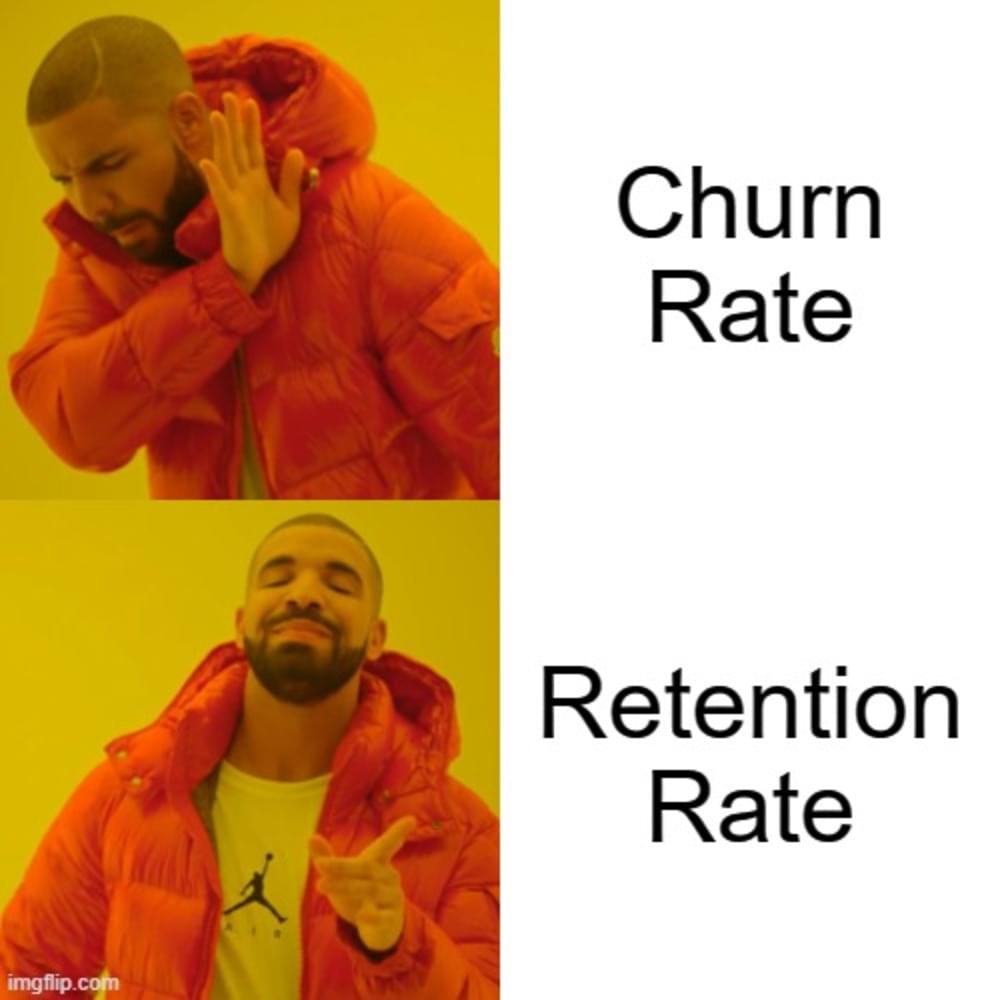
Churn Rate vs Retention Rate: How are they related?

Hey there! You’re here probably because you run a subscription-based business or any business and are confused about the terms “churn rate vs. retention rate.”
Well, don’t worry, this guide will explain all about churn rate vs retention rate. These numbers, churn rate vs. retention rate, basically show your history with your customers.
Let’s explore how churn rate and retention rate impact your business and how they are related.
Table of Content
- Churn Rate Vs Retention Rate
- Churn Rate Vs Retention Rate Formula
- Churn Rate Benchmarks
- Balancing Churn and Retention
- How Churn Rate and Retention Rate Affect Your B2B Business
- How Customer Experience affects Churn Rate and Retention Rate
- How AI helps in Lowering Churn and Boosting Retention
- Closing Thoughts
- FAQs
Churn Rate Vs Retention Rate
The churn rate is the rate at which customers unsubscribe to your service. On the other hand, the retention rate shows the rate of customers who stay. The time period of the unsubscriptions and retaining customers can be measured monthly or annually.
When churn rate falls, retention rate increases and vice versa.

Let’s say you had 100 customers when the month started and 10 left. Your monthly churn rate would be 10%. When many customers leave, it might mean they’re not happy with what you offer.
While the 90 customers who had active subscriptions show the retention rate, which will be 90% in this case.
Let’s look at the formula that helped us calculate this rate.
Churn Rate Vs Retention Rate Formula
Churn rate and retention rate are key metrics used to measure customer dynamics in a business. Here’s how to calculate retention rate and churn rate:
Churn Rate
Churn Rate=(Number of Customers at the Start of the Period/Number of Customers Lost During a Period)×100
Retention Rate
Retention Rate=(Number of Customers at the Start of the Period/Number of Customers at the End of the Period−Number of New Customers During the Period)×100
Example Calculation
Suppose a company starts with 1,000 customers at the beginning of the month. By the end of the month, they have 900 customers, and they acquired 100 new customers during the month.


So, the churn rate is 20%, and the retention rate is 80%.
Now, let’s dig deeper into churn rate and retention rate.
Churn Rate Benchmarks
Check out detailed b2b saas benchmarks here.
- SaaS Companies: Monthly churn rate averages 3-6% (Credit Suisse).
- Telecommunications: Annual churn rate averages 15-20% (Statista).
- Retail: Annual churn rate averages 25-30% (Supply Chain Insights).
CallMiner reports that U.S. companies lose $136 billion each year because of customer switching they could prevent. This huge sum shows how crucial it is to handle churn well.
Retention Rate Industry Benchmarks

- SaaS Companies: Monthly retention rate averages 94-97%.
- Telecommunications: Yearly retention rate averages 80-85%.
- Retail: Yearly retention rate averages 70-75%.
Bain & Company’s research shows that a 5% boost in customer retention can lead to a 25-95% increase in profits. This gives companies a strong reason to keep their customers satisfied!
A recent Accenture study revealed that 91% of consumers prefer to buy from brands offering relevant recommendations and deals. Also, companies that customize customer interactions see a 5-15% boost in revenue. This highlights how crucial it is to grasp customer likes and tailor experiences to meet their needs, which helps keep customers coming back.
Balancing Churn and Retention
Lower churn rates mean higher retention rates, and the opposite is also true. Together, they show you the complete picture of customer loyalty and satisfaction.
- Keep in contact with your customers. Send them personal emails and give them special deals or content. Customers who feel connected are less likely to leave.
- Don’t guess why customers leave. Ask them straight out. Use surveys and tools to gather customer feedback. Bill Gates says, “Your most unhappy customers are your greatest source of learning.”
- Let customers get help when they need it. Fast, helpful customer service can improve things. Zendesk says 62% of B2B customers bought more after they had a good experience with customer service.
- Make sure your product or service keeps meeting or beating what customers expect. Update and improve what you offer on a regular basis.
How Churn Rate and Retention Rate Affect Your B2B Business
In B2B, where it often costs more to get new customers, keeping an eye on customer retention rate vs churn rate becomes even more important. Here’s why:
Revenue Impact:
High retention rates create a more predictable and stable revenue stream. B2B companies that keep customers have a tendency to see more reliable cash flow. A 5% increase in customer retention can boost profits by 25% to 95% .
B2B companies with high churn rates (above 10%) typically see 30% lower revenue growth compared to those with low churn rates (below 5%) .
Customer Lifetime Value (CLV):
Customers who stick around have a higher CLV because they keep buying over time. This has a crucial impact on your business’s financial health. Invesp reports that loyal customers can be worth up to 10 times their initial purchase. Reducing churn rate by just 1% can increase CLV by 7% .
Companies that maintain a retention rate of 90% have CLVs that are 3-4 times higher than those with a retention rate of 80% .
Cost Efficiency:
Getting new B2B customers often costs more than keeping current ones. Focusing on retention can cut down on marketing and sales expenses. People say that finding a new customer can cost five times more than keeping an existing one (Invesp).
Increasing customer retention by 10% can lead to a 15% reduction in acquisition costs due to higher word-of-mouth referrals and lower churn rates .
Customer Satisfaction and Advocacy:
High customer retention rates compared to churn rates show trust and satisfaction. Satisfied customers are more likely to tell others about you helping your business grow.
B2B companies with a retention rate above 85% often report customer satisfaction scores 10-15% higher than those with lower retention rates .
High retention rates lead to increased customer advocacy, with satisfied customers being 50% more likely to recommend the company to others .
How Customer Experience affects Churn Rate and Retention Rate
A 2023 PwC report reveals that 73% of people consider customer experience a key factor in their buying choices. Yet 49% think companies deliver good customer experiences. Good experiences lead to higher retention rates and lower churn. It’s surprising how focusing on customer experience can have an impact on your profits.
How AI helps in Lowering Churn and Boosting Retention
A study by McKinsey & Company reveals that companies using AI to examine customer data can predict churn with up to 95% accuracy. When businesses use AI to spot at-risk customers, they can take specific steps to keep them. This approach not only makes customers happier but also cuts down churn rates a lot.
Closing Thoughts
If you liked this blog about churn rate vs retention rate and want to explore topics like these further, make sure to check out the Churnfree Blog. Here are some great articles to start with:
- What is the most direct cause of customer loyalty
- What is customer loyalty
- Average Churn rate of subscription services
- How to reduce customer churn
FAQs
What is the difference between Churn rate and retention rate?
Churn rate shows how many customers stop using your platform in a given time frame. Retention rate reveals how many customers keep using your platform over time showing how happy and loyal they are.
Is Churn rate and retention rate the same?
No, the churn rate and retention rate aren’t the same. The churn rate shows how many customers leave your platform in a specific period, while the retention rate shows how many customers stick with your platform over time.
Is retention rate the inverse of churn rate?
Yes, retention rate is basically the opposite of churn rate. If churn rate shows the percentage of customers leaving, retention rate shows the percentage of customers staying. They add up to 100% when combined.
How to reduce churn rate and increase retention
To cut down churn rate and boost retention, make your customer support better, improve your product quality, and keep in touch with customers often. Make their experience personal and start loyalty programs to encourage long-term use. Keep an eye on customer feedback and act fast to fix any problems.


